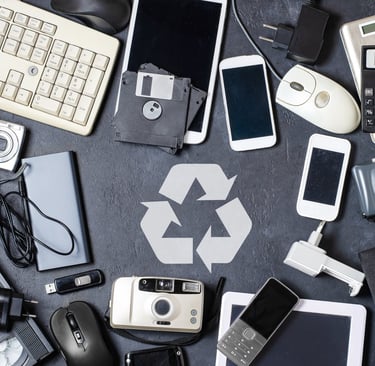The Lifecycle of Your Smartphone: Tracing E-Waste from Purchase to Disposal
By Recycle Agent | Illinois E-Waste & Data Destruction Experts
7/7/20252 min read


Smartphones have become essential to our everyday lives—connecting us to the world, streamlining tasks, and storing our most precious memories. But what happens when our devices stop working or are replaced by the latest model? This blog explores the full lifecycle of a smartphone, highlighting the hidden environmental impacts and the crucial role e-waste recycling plays in creating a more sustainable future.
1. Manufacturing: The Resource-Intensive Beginning
The lifecycle of a smartphone begins long before it reaches your hands. Manufacturing involves mining rare earth metals like lithium, cobalt, and gold—resources often extracted under harsh conditions that cause environmental degradation and human rights concerns. The energy used in production also contributes to a significant carbon footprint.
📌 Did you know? Around 80% of a smartphone’s carbon footprint occurs during manufacturing.
2. Usage Phase: The Short Lifespan of Innovation
Once purchased, most smartphones have a lifespan of 2–3 years. As new models are released, consumers are tempted to upgrade, even if their current device still functions. This short usage cycle fuels a growing volume of e-waste, as millions of phones become obsolete each year.
3. End of Life: Disposal or Second Life?
At the end of its life, a smartphone faces one of two paths:
📦 Stored in a drawer — A common fate, delaying its recycling or reuse.
🗑️ Thrown in the trash — Leading to toxic chemicals leaching into soil and water.
🔁 Responsibly recycled — Its parts can be reused or repurposed, reducing environmental harm.
Improper disposal not only wastes valuable materials but also poses significant health and ecological risks.
4. E-Waste Recycling: Closing the Loop
Recycling electronics is not just about disposal—it’s about resource recovery. When done responsibly:
Precious metals are recovered and reused in new electronics.
Toxic materials like lead and mercury are safely handled.
The demand for virgin materials is reduced, lessening the environmental toll of mining.
Choosing certified recyclers ensures your old device is handled ethically and efficiently, contributing to a circular economy.
5. What Can You Do?
✅ Extend the life of your phone by using protective gear and software updates.
✅ Donate or resell functioning devices to extend their use.
✅ Recycle with certified e-waste programs like Recycle Agent.
✅ Educate others about the importance of responsible disposal.
Conclusion
Your smartphone's journey doesn’t end when you stop using it. By understanding its lifecycle—from raw materials to disposal—you can make informed, eco-conscious decisions. Embracing responsible recycling helps protect the planet and ensures that valuable resources are put to good use.
Let’s close the loop—one device at a time.
